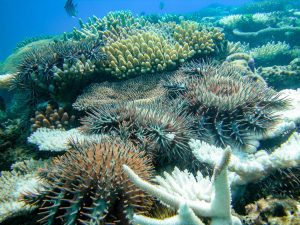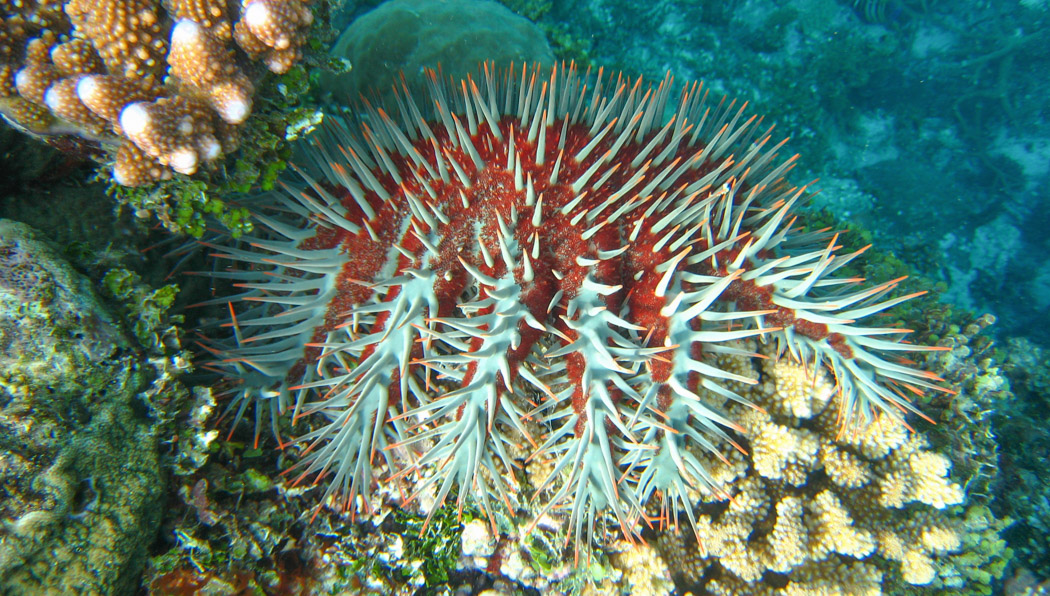
TUSCALOOSA, Ala. — A University of Alabama researcher is part of a team that identified genes used to communicate by a starfish that preys upon coral reefs, a promising discovery that could lead to efforts to repel the aquatic pest from sensitive reefs.
The findings, published in the journal Nature, are the first insight into what chemicals attract and repel the crown-of-thorns starfish and suggest a method of mitigating other marine nuisances.
“This sea star is an absolutely huge problem, and it’s become clear that traditional tools are never going to keep up with it,” said Dr. Kevin M. Kocot, UA assistant professor of biological sciences and co-author on the paper. “Other, more clever approaches are needed to control it on a species-wide basis.”
Normally a part of a healthy coral ecosystem, the crown-of-thorns starfish has become abundant, possibly because warmer, more nutrient-rich water allows more larval starfish to survive into adulthood and because of overfishing of its main predator – a sea snail called the giant triton.
An average adult starfish roughly 16 inches across can kill about 75 square inches of live coral daily, and an outbreak of the starfish can mean thousands grazing across a coral reef. Humans have tried several ways of relieving coral during an outbreak, including removing the starfish by hand, killing them with chemical injections and even a robot that continuously hunts them.
However, researchers at the University of Queensland and the University of the Sunshine Coast in Australia, along with collaborators at the Okinawa Institute of Science and Technology in Japan, hope to use the starfish’s own communication to keep them off coral reefs.
The crown-of-thorns starfish does not see well, but certain chemicals it releases attracts larvae to settle near adults, resulting in huge aggregations. The researchers focused on these chemicals, which make the normally sedentary starfish highly active.
Kocot, whose main research interests are bioinformatics and genomics of invertebrates, analyzed the genomes of two individuals of the crown-of-thorns starfish, one from the Great Barrier Reef, Australia, and another from Okinawa, Japan.
Kocot helped to identify certain genes that act as receptors for the specific chemicals. The receptors and chemicals act as a lock and key in that only certain smells fit with certain receptors, Kocot said. Conveniently, both individuals of this species, which span its geographical range , have nearly identical sequences for many of these genes, he said.
“These genes seem to be conserved within the species, which makes us optimistic that if we develop a bait or something similar, it should work broadly,” Kocot said. “At least now that we know the genes that seem to be important, we can more easily survey a lot of individuals for those particular genes and then know for sure.”
While the starfish clumps based on one set of chemicals, the giant triton repels the starfish with another. Receptors used by the starfish to detect the snail could also be leveraged in developing a repellent, Kocot said.
More research is needed, including experimental work in aquariums, before large-scale methods can be attempted in the ocean, but Kocot said researchers are optimistic after sequencing the starfish’s genes that manipulating communication could save coral reefs from further overpopulation of this predator.
Contact
Adam Jones, UA media relations, 205/348-4328, adam.jones@ua.edu
Source
Dr. Kevin M. Kocot, assistant professor of biological sciences, 205/348-4052, kmkocot@ua.edu
